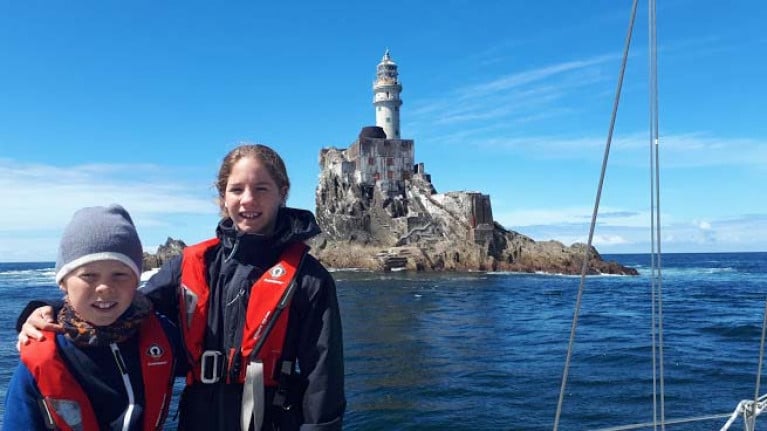Last June, in what was meant to be the mid-summer period, Ireland was experiencing notably unseasonal weather with winds in the northerly sector which were cold - as anyone who took part in the biennial Dun Laoghaire Dingle Race will agree. Yet those cold winds were fair winds for anyone bound south down the Atlantic seaboard, and even as the racers to Dingle were settling into their post-race partying, an able-looking steel ketch came into port, crewed by a family who looked as though they’d appreciated the favourable passage-making conditions which had brought them and their dream ship down from Galway Bay at the start of a 14-month Atlantic circuit cruise.
Their dream ship is Danu, a rugged yet stylish Bruce Roberts-designed 13m Mauritius ketch, originally built in 1993 but brought up to superb condition by Vera Quinlan and her partner Peter Owens for this Atlantic project to provide a seagoing home (and schoolroom) for the couple and their two children, Lilian who was eleven when the voyage started from Kinvara last June, and nine-year-old Ruari.
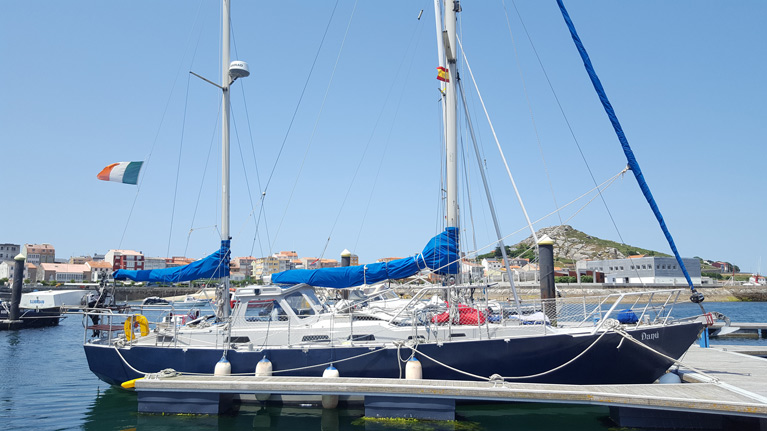 You don’t need extensive varnish work for a boat to look very well – the eminently practical Danu is a Bruce Roberts-designed 13m steel Mauritius Class ketch built in 1993. Photo: Vera Quinlan
You don’t need extensive varnish work for a boat to look very well – the eminently practical Danu is a Bruce Roberts-designed 13m steel Mauritius Class ketch built in 1993. Photo: Vera Quinlan
Vera Quinlan is “maritime royalty” – there’s no other way to put it. These days she’s a hydrographer on the INFOMAR project with the Marine Institute in Galway after years of international experience at sea and ashore completing research projects. And her sailing career well matches her professional life, for she’s a daughter of innovative architect Fergus Quinlan, who built his own 12m steel van de Stadt cutter Pylades, which he sailed round the world with his wife Kay in 2009-2012.
With this background, Vera was sailing her own Mirror dinghy by the age of 11, she then went on to Lasers, and by 16 she’d sailed on Asgard II during the visit to Australia in 1988, “an amazing and inspirational experience”.
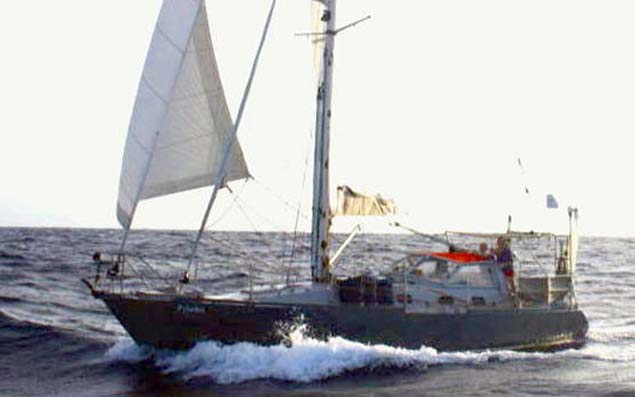 Fergus & Kay Quinlan’s Pylades, which he built himself and they sailed round the world in 2009-2012
Fergus & Kay Quinlan’s Pylades, which he built himself and they sailed round the world in 2009-2012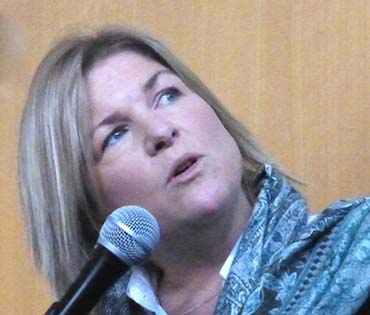 Vera Quinlan talking on marine research and the INFOMAR programme at an Irish Sailing Cruising Conference. Photo: W M Nixon
Vera Quinlan talking on marine research and the INFOMAR programme at an Irish Sailing Cruising Conference. Photo: W M Nixon
Cruising with her father when possible was another part of the seagoing mix, and when she linked up with adventurer and mountaineer Peter Owens, his lack of sailing experience was soon put right by getting her old Laser back into sailing trim, and putting him afloat to learn the basics. He needed to, for things seemed to be happening very quickly, as they got married and planned the honeymoon as a 15-month Atlantic circuit cruise fifteen years ago in the borrowed Pylades.
After that, they settled in the west of Ireland where the Clan Quinlan over three generations have made the southeast corner of Galway Bay their new ancestral home, and life has been decidedly busy and very maritime ever since. The international hydrography projects have played a key role in our growing understanding of the secret special world which surrounds our island, but with their new family of daughter Lilian and son Ruari taking to the waterborne life, Vera and Peter were determined that when the right time came, they’d have themselves organised with the right boat to take a 15-month sabbatical so that the four of them could enjoy the Atlantic circuit cruise together in that magic period when the children are old enough to fully experience the adventure, yet haven’t reached the age when they start having ideas of striking out on their own.
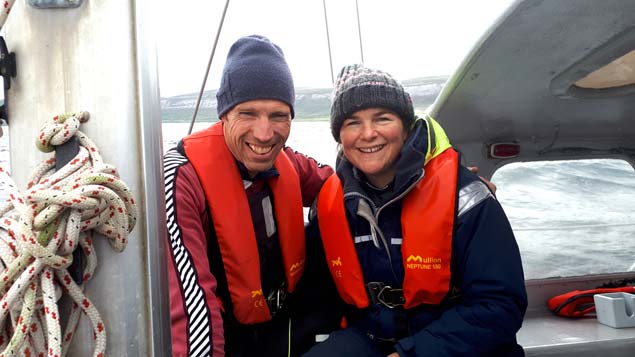 Peter and Vera on Danu on the day of their departure from Galway Bay in June 2019. Photo: Pierce Purcell
Peter and Vera on Danu on the day of their departure from Galway Bay in June 2019. Photo: Pierce Purcell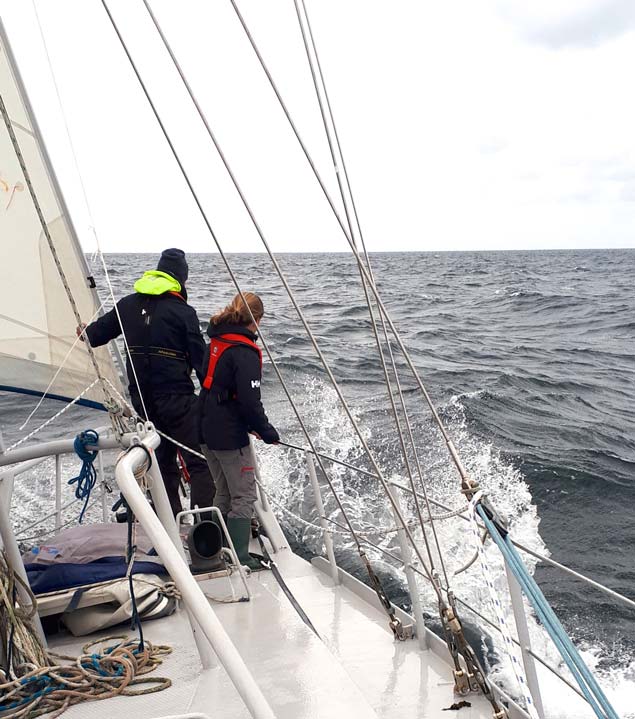 The winds for the first day of the voyage in Galway Bay may have been cold, but they were fair winds, and Danu’s crew were on dolphin watch before they’d got beyond the Aran Islands. Photo: Vera Quinlan
The winds for the first day of the voyage in Galway Bay may have been cold, but they were fair winds, and Danu’s crew were on dolphin watch before they’d got beyond the Aran Islands. Photo: Vera Quinlan
That said, when you’re as broadly and deeply involved in the maritime world as Vera Quinlan, describing an ocean cruise as “taking a sabbatical” doesn’t really get the flavour of it. She observes at it all with a special and professional viewpoint, and as reported in Afloat.ie on Thursday, the voyage of the Danu was used to locate an Argo research and recording float in mid-Atlantic between the Cape Verde Islands and French Guiana, an area which would normally be well beyond the scope of the Marine Institute in Galway.
Then too, Peter Owens has his own background in shoreside adventure and mountaineering, and the voyage has seen Danu being left securely berthed in some convenient harbour while the family venture inland to take on challenging mountain ranges such as the mysterious Picos de Europa in northern Spain, and the Atlas Mountains in North Africa.
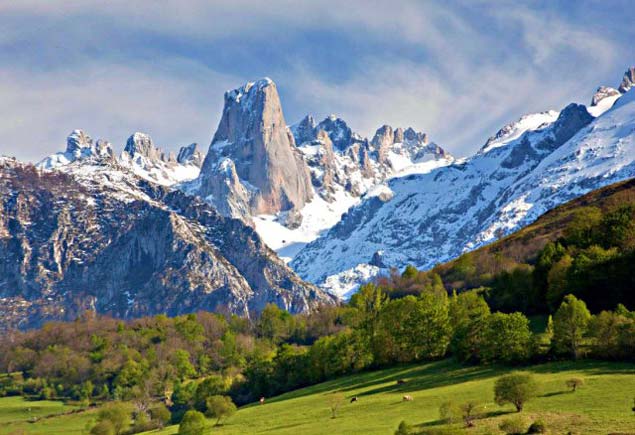 It wasn’t all “blue days at sea”. With Danu in a safe berth in Galicia, her crew went off to explore the mysterious Picos de Europa in Northern Spain
It wasn’t all “blue days at sea”. With Danu in a safe berth in Galicia, her crew went off to explore the mysterious Picos de Europa in Northern Spain
The entire hugely-varied experience is kept in context by relating it to the family’s home base in Kinvara, their links to the North Clare community around Bell Harbour, and with Galway Bay Sailing Club, which in 2020 is celebrating its Golden Jubilee.
Yes indeed, GBSC is fifty this year. And though reaching your 50th Anniversary may seem modest enough in a year when clubs in Ireland are celebrating Tricentenaries, Quarter Millenniums, Bicententaries, Sesquicentennials, 125th Anniversaries and whatever, getting a coastal sailing club going in Galway fifty years ago was a major achievement.
Then too, it’s doubtful if any of the more senior clubs have a member family undertaking an ocean cruise as complete as the Quinlan/Owen team during GBSC’s Golden Jubilee Year. So as Danu was leaving Vera promised that she’d send a Golden Jubilee Voyage Update by the end of January 2020, and thanks to that promise we can give this illuminating and practical insight into a true dream voyage.
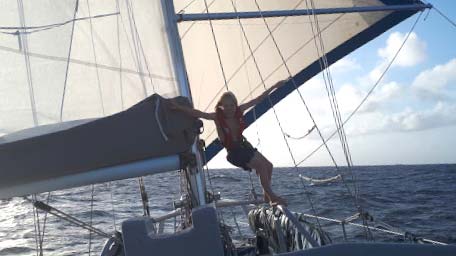 Lilian enjoying her first experience of Tradewind sailing. Photo: Vera Quinlan
Lilian enjoying her first experience of Tradewind sailing. Photo: Vera Quinlan
On 19th January Vera wrote:
“Danú and crew (Peter Owens, Vera Quinlan, Lilian (12) and Ruairí (10) all well, and enjoying the Caribbean islands. To date we have sailed 6500 nm from Kinvara south bound to the Isles of Scilly, Brittany, Galicia in northwest Spain, Portugal, Morocco, Madeira, Canaries, Cape Verde Islands and across the Atlantic to French Guiana.
With many miles under the keel to date, we have had plenty of sailing adventures. A few things stand out:
Entering into Rabat, Morocco under its ancient citadel, crossing the bar and negotiating ferries crossing the Bouregreg river. Then the harbour at Porto Santo, Madeira was an unexpected gem. We much enjoyed meeting Conor and Breda Minogue from Kinvara in Tenerife - they had chartered a yacht.
We experienced 30 knot plus winds and 4m seas from the Canaries to Cape Verde (Ed note: This region can see the Northeast Trade Winds in decidedly brisk mood – it was at the Canaries that Conor O’Brien with Saoirse recorded the best day’s run of his entire 1923-25 Round the World Voyage – it was 185 miles, and he reckoned they would have broken the 200 with an able alternative helm).
Vera resumes: We also happily recall the wonderful Bahia de Ferrios on Isla Brava of the Cape Verdes, where we filled with fresh water, and got ready for the Atlantic passage, preparing for the open ocean after some notable inland experiences, for we had left the boat in safe berths twice in order to explore the Picos de Europa in Northern Spain, and the Atlas in Morocco. The latter involved a challenging trek through semi-desert terrain of the Jebel Saghro region. We walked 150 km over the 6 days, sometimes in temperatures over 30 degrees.
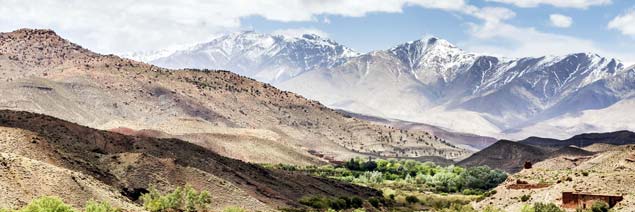 And now for something completely different…..the Atlas Mountains in Morocco involved Danu’s crew in a six-day trek
And now for something completely different…..the Atlas Mountains in Morocco involved Danu’s crew in a six-day trek
Thus the prospect of a real sea voyage was refreshing, but as it was the first proper ocean voyage for Lilian and Ruari, we’d planned the Atlantic crossing to be at one of the shortest hops, from the Cape Verdes across to French Guiana in South America.
For this passage across, we were joined by my cousin Chris Lacy, who had just completed his Yachtmaster qualification and wanted an Atlantic passage under his belt. We departed on the 29th November from Brava. The first few days we enjoyed great downwind sailing conditions, running with main and poled out genoa. We reefed and un-reefed as the conditions allowed, our average speed 6 knots, and daily runs of 145 nm.
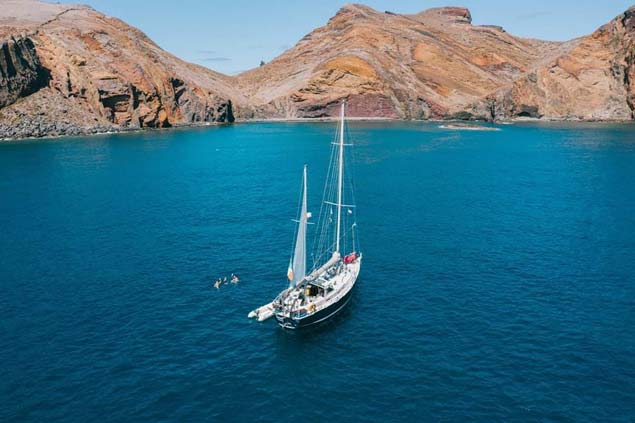 The Cape may be Verde, but some of the islands aren’t, yet Danu’s crew much enjoyed Bahia de Ferrios on Isla Brava before departing across the Atlantic. Photo: Vera Quinlan
The Cape may be Verde, but some of the islands aren’t, yet Danu’s crew much enjoyed Bahia de Ferrios on Isla Brava before departing across the Atlantic. Photo: Vera Quinlan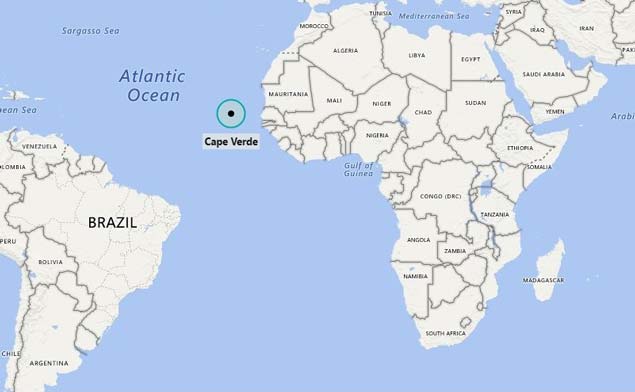 By making their Atlantic crossing from the Cape Verdes to French Guiana on the South American mainland, Danu’s crew reduced the passage time to 13 days.
By making their Atlantic crossing from the Cape Verdes to French Guiana on the South American mainland, Danu’s crew reduced the passage time to 13 days.
For weather forecasting, we had planned on our satellite phone to download gribs from Predict wind. Unfortunately, we had a problem with the phone data cable and so we resorted to a voice call every two days to Fergus and Kay Quinlan beside Bell Harbour on the north coast of The Burren. They would note our position and current weather conditions and then send us a weather update by text. This worked very well, and it was wonderful through the miracle of modern technology to talk directly to someone in County Clare from the mid-Atlantic.
Four days into our crossing, we started to experience squalls with heavy rain showers, some of them torrential, allowing us to fill 5L water bottles from the coach-roof in minutes. Squalls would come in with ferocious intensity, and lightning was seen in the distance.
We ran dark with all electronics disconnected in case the electrical activity caught up us. It finally did on the morning of the 5th December, when a massive lightning bolt discharged a few meters from Danu's stern. We sailed on as quickly as possible, eventually getting somewhat clearer weather. We were informed from our Bell Harbour weather forecasters that the Inter Tropical Convergence Zone (ITCZ) had moved northwards, and as our Great Circle route was bringing us to 5 degrees North, we had no choice but to sail through it.
We enjoyed much brighter weather the following day, and we were able to deploy our Argo float. We had carried this instrument since leaving Ireland, a project we coordinated with the Marine Institute. This float will record temperature and salinity data from 2000m to surface level, on surfacing the instrument will download this data to the Marine Institute to aid climate change research. This Argo float will make this continuous 10-hour cycle for a period of 4 years.
Thanks to the Quinlan-Owens family from Galway for sharing this video of the deployment of a Marine Institute Argo Float in December.
— Marine Institute (@MarineInst) January 23, 2020
For more on this story please see - https://t.co/yWmgLbTLdD #marine #argofloat #ocean #data #research @EuroArgoERIC pic.twitter.com/5TXeTWZ9io
Despite pitching in the Atlantic swell we managed to deploy the float successfully, and our Mission Control Centre in the Burren relayed the message to the Argo team at the Marine Institute. A few days later we got the notification that the float was transmitting data successfully. Celebrations all around, as it is a first for Ireland to have an Argo float in this location.
Up to the 8th of December, we had the Trans-equatorial current with us, enabling good daily runs. On the 9th December, around 6deg40'N, 46deg22'W, we ran into a knot of countercurrent, and experienced swells from three different bearings. This made the sailing slow and uncomfortable – it’s amazing how seemingly small changes outboard can affect overall mood onboard…….
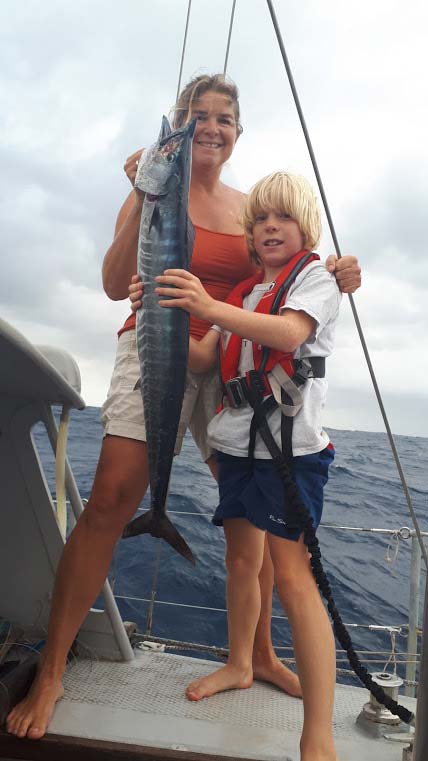 Something for immediate consumption and the larder. They don’t come fresher than a fish catch in mid-Atlantic. Photo: Chris Lacy
Something for immediate consumption and the larder. They don’t come fresher than a fish catch in mid-Atlantic. Photo: Chris Lacy
On the bright side, we caught some fantastic deep ocean fish such as dorade and wahoo which made delicious fresh eating, and provided huge excitement. Then by the 11th December after two days of adverse current, we started to pick up the favourable Guiana current, increasing as we sailed west. We made landfall at the Iles du Salut on the morning of the 12th December, making for a compact 13 day Atlantic passage.
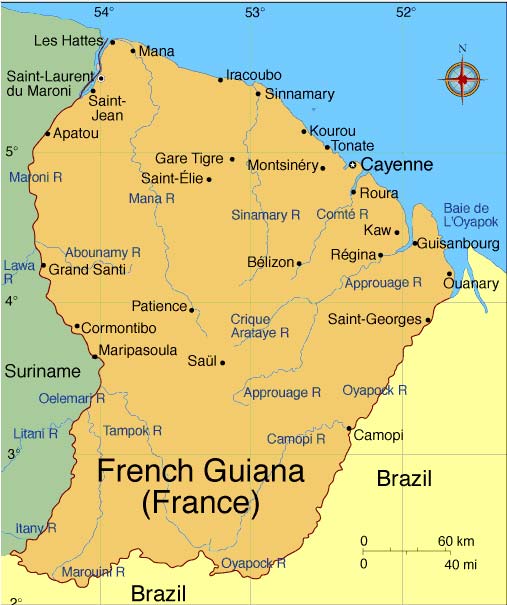 A very tropical place, French Guiana is slotted into South America between Brazil and the Dutch-linked Surinam.
A very tropical place, French Guiana is slotted into South America between Brazil and the Dutch-linked Surinam.
Notorious for being a former French penal colony centred around the infamous Devil’s Island in the north of the little group, the Salut Islands nowadays are a convenient stop before clearing into the French Guiana mainland. Relics of the old prisons remain, an eerie reminder of the times where France's most dangerous prisoners were sent, many never to leave the islands. They were made even more famous by the publication of the book 'Papillon', thrilling reading which acquired deeper meaning after seeing the place, particularly if you’ve sailed there - free as a bird - in your own boat.
After a few days exploring the islands, we left for the nearest mainland port at Kourou, marvelling at the shallow depths from there to the South American mainland. We spent three weeks in French Guiana, with one of the highlights being a Soyuz launch from the Space Center near Kourou - being so near the Equator, Kouro provides the minimum distance to Inner Space.
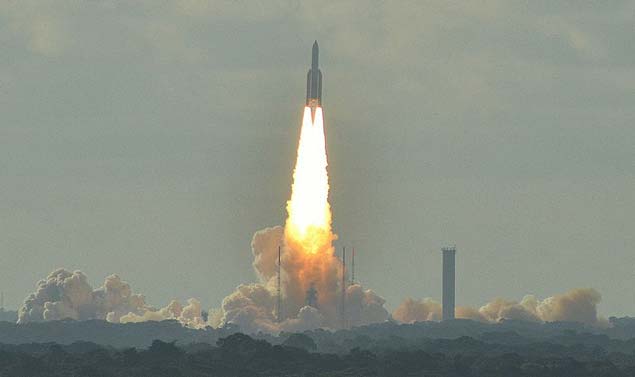 Not something you’ll see on most cruises, yet Danu’s crew saw this happen at the Guiana Space Center in December.
Not something you’ll see on most cruises, yet Danu’s crew saw this happen at the Guiana Space Center in December.
In complete contrast to space travel, we navigated a narrow tributary of the Maroni River which marks the western boundary of French Guiana to anchor off an Amerindian settlement. Bringing Danú through a river where the trees of the rainforest almost touched the spreaders, yet with 10m depth beneath us, was incredible. We had Christmas dinner off the river port of St Laurent Du Maroni, managing to find a micro turkey in a local supermarket, while Santa read the GPS coordinates we sent and found us successfully……
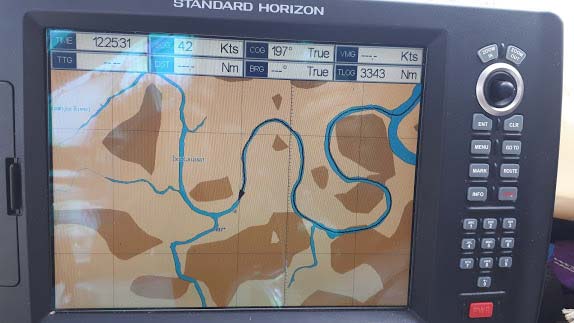 A very unusual place to spend Christmas, yet thanks to having the correct co-ordinates, Santa Claus managed to find Danu up this winding tropical river. Photo: Vera Quinlan
A very unusual place to spend Christmas, yet thanks to having the correct co-ordinates, Santa Claus managed to find Danu up this winding tropical river. Photo: Vera Quinlan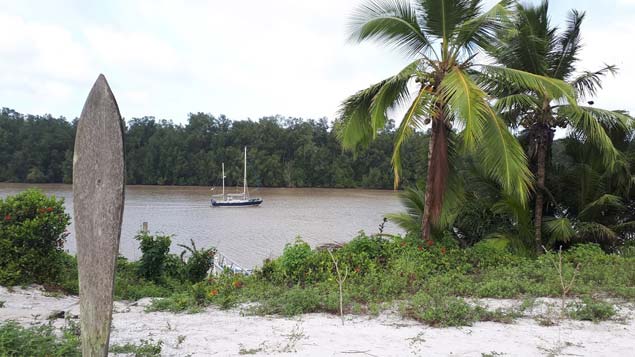 How far can you get in place and mood from Kinvara in December? Danu in a tributary of the Maroni River in French Guiana. Photo: Vera Quinlan
How far can you get in place and mood from Kinvara in December? Danu in a tributary of the Maroni River in French Guiana. Photo: Vera Quinlan
French Guiana was definitely off the beaten track, with only a few boats of the 500 plus that crossed the Atlantic this season. We enjoyed going off the beaten track, but the almost constant rain, 100% humidity and mosquitoes were challenging, and we wondered how anyone would choose to live here. On Stephen's Day we departed for Bequia in the Caribbean, making the passage in 4 days.
Sailing on a fast reach in relatively calm sea conditions with 1.5 knots of Guyanian current was truly memorable. We sailed into Admiralty Bay, Bequia, marvelling at the crystal clear waters after so many days in the muddy cayman and piranha-filled rivers of French Guiana. Ruairi and Lilian were over-board and into the sea moments after we dropped anchor, and we welcomed friendly waves from many boats we had not seen since the Canaries.
We were elated to be here, having previously sailed into Bequia fifteen years previously on Pylades.
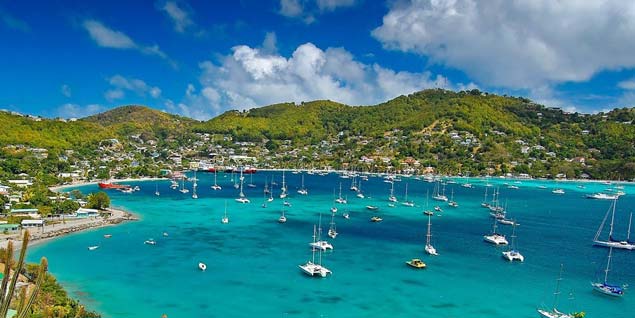 Bequia is in marked contrast to the muddy rivers and tropical rain of French Guiana
Bequia is in marked contrast to the muddy rivers and tropical rain of French Guiana
Now we are anchored in Chatham bay off Union Island. The weather has been uncharacteristically marked by high winds and rain showers so we have stayed here for four days, exploring Union by foot, the best being a hike through the forest to the highest point called 'da pinnacle'. On the way, you see tortoises, snakes, hummingbirds, hermit crabs and the unique Union Island gecko. The views from the summit are superb looking over to Clifton, the capital, with the islands of Petit Martinique and Petit St Vincent beyond. The reefs and special anchorages of the Tobago Cays are now beckoning, to which we depart in the morning. Meanwhile, warmest Golden Jubilee greetings to Galway Bay Sailing Club
Vera Quinlan
Peter Owens
Yacht Danú in the Caribbean
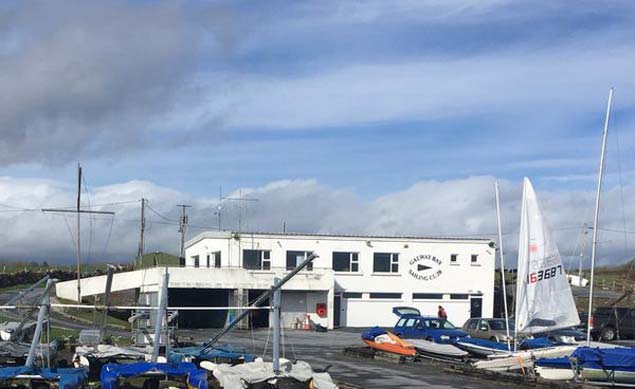 Home club. Galway Bay SC is celebrating its Golden Jubilee in 2020
Home club. Galway Bay SC is celebrating its Golden Jubilee in 2020



























